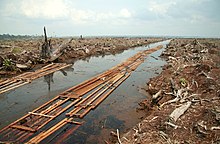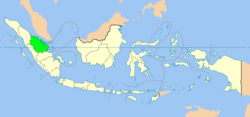 Riau Riau | |||
|---|---|---|---|
| — Province — | |||
| |||
| Location of Riau in Indonesia | |||
| Coordinates: 0°32′N 101°27′E / 0.533°N 101.45°ECoordinates: 0°32′N 101°27′E / 0.533°N 101.45°E | |||
| Country | Indonesia | ||
| Capital | Pekanbaru | ||
| Government | |||
| - Governor | Rusli Zainal | ||
| Area | |||
| - Total | 72,569 km2 (28,019 sq mi) | ||
| Population (2010)[1] | |||
| - Total | 5,543,031 | ||
| - Density | 76.4/km2 (197.8/sq mi) | ||
| Demographics | |||
| - Ethnic groups | Malay (38%), Javanese (25%), Minangkabau (11%), Batak (7%), Banjarese (4%), Chinese (4%), Buginese (2%) [2] | ||
| - Religion | Muslim (88%), Protestant (1%), Catholic (5%), Buddhist (6%), Hindu (0.2%) | ||
| - Languages | Malay, Indonesian, Minangkabau | ||
| Time zone | WIB (UTC+7) | ||
| Website | www.riau.go.id | ||
Riau is a province of Indonesia, located in the center of Sumatra along the Strait of Malacca. The provincial capital and largest city is Pekanbaru. Other major cities includes Dumai, Bagansiapiapi, Bengkalis, Bangkinang, Rengat and Siak Sri Indrapura.
Indonesian was based on the Riau version of Malay language.
Riau is currently one of the richest provinces in Indonesia. This province is rich with natural resources, particularly petroleum, natural gas, rubber, palm oil and fiber plantations. However extensive logging lead to massive decline of forest cover from 78% in 1982 to only 33% in 2005.[3]
The Riau Islands were part of Riau province until 2004, when they were made a separate province.
Since 1970s, the majority of Indonesia has been experiencing declining population growth rates. Riau has been a significant exception, with increasing rates every decade since 1970 to 4.35 percent annual rise for the 1990s.[4] The provincial population is 5,543,031 (As of the 2010 census).[1]
Contents[hide] |
[edit] Language
Riau is home to various dialects of the Malay and Chinese language. The dominant language used by the Malay population is Riau Malay, on which the national language, Indonesian, is based. The Chinese population speaks a Min Nan language known as Riau Hokkien. This language originated in the southern part of Fujian province in the south-eastern part of China.
[edit] Riau Indonesian
The dialect of Indonesian spoken in this region is considered by linguists as having one of the least complex grammars among the languages of the world (apart from creoles), possessing neither noun declensions, nor temporal distinctions, nor subject/object distinctions, nor singular/plural distinction. For example, the phrase Ayam makan (lit. 'chicken eat') can mean, in context, anything from 'the chicken is eating', to 'I ate some chicken', 'the chicken that is eating' and 'when we were eating chicken'.[5] A possible reason for this is that Riau Indonesian has been used as a lingua franca for communication between different people in this area during its history, and extensive foreign-language use of this kind tends to simplify the grammar of a language used.[6]
Riau Indonesian served as a basis for the modern national language, Indonesian, which however has extensive additional influence from Javanese, Chinese, Arabic, Dutch and English, among others.[citation needed]
[edit] Cities and Regencies
- Pekanbaru City
- Dumai City
- Rokan Hilir Regency
- Rokan Hulu Regency
- Siak Regency
- Indragiri Hilir Regency
- Indragiri Hulu Regency
- Pelalawan Regency
- Kampar Regency
- Bengkalis Regency
- Kuantan Singingi Regency
- Meranti Islands Regency
[edit] Economy
The economy of Riau expanded faster (8.66% in 2006) than the Indonesian average (6.04% in 2006). Largely a resource-based economy, including crude oil (600,000 bpd), palm oil and other forest products. Local government income benefits from a greater share of revenue of tax (mainly crude oil) due to the decentralization law in 2004.[7]
[edit] Ecology

The province was once heavily forested lowlands, but with palm oil plantations and logging being major industries it is losing around 2,000 square km of forest per year. In 2005 the forest cover was down to 33% (or 27.000 square km) from 78% (or 64.000 square km) in 1982.[8]
Riau regularly suffers, from smoke and haze due to land-clearing fires for oil palm plantations during the two dry seasons a year that occur (late Jan - early March and again June - September). The fires occur because small - medium size business, community cooperation units (KUD's), and individual community members "slash and burn" the forest vegetation and replace it with oil palm and/or rubber plantations. Fire is still viewed by the people and government officials as a useful and inexpensive tool for clearing land for oil palm (which is everyone's desire to own at least 2 hectares for financial security), despite the environmental impacts on forest destruction, air quality, green-house gas emissions and effects of smoke/haze on the health of children, elderly, and general population.
Being a province with a predominantly low relief, the coastal regions are rapidly losing land to the ocean.
(copy of wikipedia)




No comments:
Post a Comment